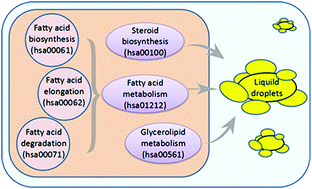当前位置:
X-MOL 学术
›
Mol. Omics
›
论文详情
Our official English website, www.x-mol.net, welcomes your feedback! (Note: you will need to create a separate account there.)
Gene expression profile-based drug screen identifies SAHA as a novel treatment for NAFLD
Molecular Omics ( IF 2.9 ) Pub Date : 2019-01-03 , DOI: 10.1039/c8mo00214b Zhujun Cheng 1, 2, 3 , Yusong Wen 1, 2, 3 , Bowen Liang 2, 3, 4 , Siyang Chen 2, 3, 4 , Yujun Liu 2, 3, 5 , Zang Wang 2, 3, 4 , Jiayu Cheng 2, 3, 6 , Xiaoli Tang 2, 3, 7 , Hongbo Xin 1, 2, 3 , Libin Deng 1, 2, 2, 3, 7
Molecular Omics ( IF 2.9 ) Pub Date : 2019-01-03 , DOI: 10.1039/c8mo00214b Zhujun Cheng 1, 2, 3 , Yusong Wen 1, 2, 3 , Bowen Liang 2, 3, 4 , Siyang Chen 2, 3, 4 , Yujun Liu 2, 3, 5 , Zang Wang 2, 3, 4 , Jiayu Cheng 2, 3, 6 , Xiaoli Tang 2, 3, 7 , Hongbo Xin 1, 2, 3 , Libin Deng 1, 2, 2, 3, 7
Affiliation

|
Non-alcoholic fatty liver disease (NAFLD) is the most common chronic liver disease worldwide. Being part of the metabolic syndrome, NAFLD is characterized by the deposition of triglycerides (TGs) as lipid droplets in the cytoplasm of hepatic cells. Recently, the rapid development of high-throughput genome analysis technologies provided opportunities to screen for new drugs for NAFLD. In this study, we screened for potential drugs based on the gene expression profiles of 73 compounds and identified histone deacetylase (HDAC) inhibitors as a novel treatment for the accumulation of lipids in hepatocytes. In the subsequent analysis and experiments, we discovered that SAHA inhibited the fatty acid and lipid metabolism pathways in hepatic cells and induced a significant deficiency of lipid accumulation in HepG2 and SMMC-7721 cells. Furthermore, SAHA inhibited lipid synthesis in hepatic cells by directly suppressing the expression of DGAT2. Hence, our study provides a novel method to screen for effective drugs for liver diseases and identifies SAHA as a potent treatment for NAFLD.
中文翻译:

基于基因表达谱的药物筛选确定SAHA为NAFLD的新疗法
非酒精性脂肪性肝病(NAFLD)是全世界最常见的慢性肝病。作为代谢综合征的一部分,NAFLD的特征是甘油三酸酯(TGs)作为脂质小滴沉积在肝细胞的细胞质中。最近,高通量基因组分析技术的迅速发展为筛选NAFLD的新药提供了机会。在这项研究中,我们根据73种化合物的基因表达谱筛选了潜在的药物,并确定了组蛋白脱乙酰基酶(HDAC)抑制剂是一种治疗肝细胞脂质蓄积的新方法。在随后的分析和实验中,我们发现SAHA抑制了肝细胞中的脂肪酸和脂质代谢途径,并导致HepG2和SMMC-7721细胞中脂质蓄积的明显不足。此外,SAHA通过直接抑制DGAT2的表达来抑制肝细胞脂质的合成。因此,我们的研究提供了一种筛选有效的肝病药物的新方法,并将SAHA鉴定为NAFLD的有效治疗方法。
更新日期:2019-02-13
中文翻译:

基于基因表达谱的药物筛选确定SAHA为NAFLD的新疗法
非酒精性脂肪性肝病(NAFLD)是全世界最常见的慢性肝病。作为代谢综合征的一部分,NAFLD的特征是甘油三酸酯(TGs)作为脂质小滴沉积在肝细胞的细胞质中。最近,高通量基因组分析技术的迅速发展为筛选NAFLD的新药提供了机会。在这项研究中,我们根据73种化合物的基因表达谱筛选了潜在的药物,并确定了组蛋白脱乙酰基酶(HDAC)抑制剂是一种治疗肝细胞脂质蓄积的新方法。在随后的分析和实验中,我们发现SAHA抑制了肝细胞中的脂肪酸和脂质代谢途径,并导致HepG2和SMMC-7721细胞中脂质蓄积的明显不足。此外,SAHA通过直接抑制DGAT2的表达来抑制肝细胞脂质的合成。因此,我们的研究提供了一种筛选有效的肝病药物的新方法,并将SAHA鉴定为NAFLD的有效治疗方法。



























 京公网安备 11010802027423号
京公网安备 11010802027423号